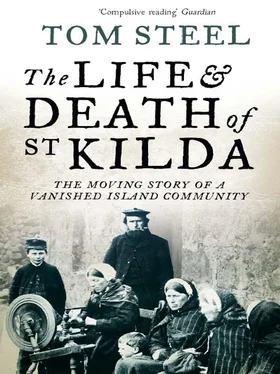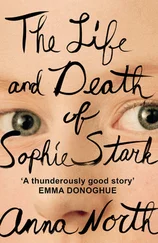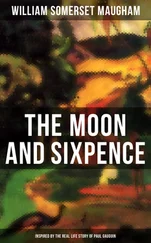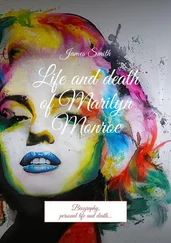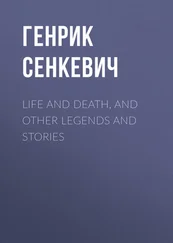If it was a ‘Parliament’, it was one that perhaps met the needs of those it served better than any other. There were no ‘headmen’ in parliament. Every islander had an equal right to speak, and to cast an equal vote. It was an assembly that had no government. There was always a total lack of distinction upon St Kilda. No islander held sway over his fellow islanders. Equally, no rules governed the conduct of the morning meeting. The men arrived in their own time, and at the meeting, according to observers, everyone appeared to talk at once.
If the proceedings of the day were important, the morning meeting would waste little time. If a visit to one of the neighbouring islands or stacs to tend the sheep or kill the sea birds was in order, the men would be quick to get to the work at hand. If, however, there was little of urgency that required to be done, the meeting could and would often sit all day in discussion. A break for lunch would be taken as and when the proceedings allowed, but otherwise talk would be the work of the day. ‘Upon the whole,’ wrote John Ross, ‘the St Kildans are just as much engaged as their crofter neighbours in the Outer Hebrides and although they do at times spend much more time than is necessary over “parliamentary” affairs, they often derive benefit from it inasmuch as any stray piece of useful information picked up by a single individual is imparted to the whole.’ The adventures of those who had had the opportunity to visit the mainland were related in great detail to the assembled throng. Information such as the cost of buckets and spades in the great metropolis of Glasgow and what wonderful shops were to be found there were not the only subjects of great interest. The most important function of the morning meeting was the exchange of views and the sharing of experiences.
The St Kildans never regarded themselves as individuals. Each and every one was a component of a community. The daily meeting was that which held them together, even though ‘Parliament’ was often the market place of gossip. ‘Very often,’ said Ross, ‘“my neighbour” and anything he has done out of the way, whether it is right or wrong’, were matters to be examined by the assembled islanders. Discussion frequently spread discord, but never in recorded history were feuds so bitter as to bring about any permanent division within the community. Perhaps the fact that criticism was aired so readily ensured that gossip was never allowed to get out of hand.
The laws that governed the island were equally of the people’s own making. Although formally subject to the law of the rest of Scotland, there was never an instance when those laws were either enforced or needed to be. ‘Murder, of course, from the impossibility of escape and the absence of the usual causes of incitement is unknown in their traditions,’ wrote George Atkinson, ‘and dishonesty from similar causes very nearly so; a case of adultery has never been known among them, and as no fermented or spirituous liquor is made on the island, and they only receive a trifling half-yearly supply from the Tacksman, they are of necessity sober.’
The St Kildans looked to the Bible for their laws. In most respects they abided by the laws laid down by Moses in the Old Testament. How such a corpus of law became embodied in the community is unknown, but Macaulay in 1758 probably correctly believed that missionaries must, at an early date, have converted the St Kildans to accept such a code of behaviour.
Only the elders of the Church had authority over the rest of the community. They were responsible for sharing out the produce of the islanders’ labours equally. Should there be any difficulty, the distribution would be settled by lot. The division of native labour was always carried out to the satisfaction of all concerned. After the harvesting of the sea birds, the catch of each day was placed in one great heap, usually on the foreshore, and was then divided out according to the number of households on the island. ‘At the end of the day’s fowling,’ wrote Christina MacQueen at the time of the evacuation, ‘the sharing began. Grouped around the large heap of slain fulmars stood the representatives of every family. In the rear the women and juveniles waited; waited to carry their portion to the cottage, where the plucking would immediately begin. The larger the family, the bigger the share. There was no such thing as payment by results. Such a practice is only necessary where the thing, miscalled “civilization” has blunted the natures of men, and made them selfish and callous, and brutal to their fellows.’
The sick, the young and those who were old and lived alone were always cared for. ‘The St Kilda community’, remarked Wilson in 1841, ‘may in many respects be regarded as a small republic in which the individual members share most of their worldly goods in common, and with the exception of the minister, no one seems to differ from his neighbour in rank, fortune, or condition.’ The St Kildans throughout their history never included either ministers, missionaries, nurses, or schoolmasters in the sharing out of their food, be it the carcass of fulmar, gannet, or sheep. They were always regarded as outside the community. All received a part of the community’s produce as a gift; none of them ever received a share as a right.
Like every system of sharing, there were exceptions to the general rule. Any St Kildan, for instance, who killed a young fulmar or gannet ‘out of its nest’ was allowed to keep the bird for himself. The justification for such an exception was that if he had not taken the bird, it would either have died a natural death or have been swallowed up by a raven or a crow. By 1880, the fulmar and the puffin were the only birds subject to equal division. By that time, apart from homespun tweed, their feathers and oil were the only staples used to pay the rent, a concern always regarded as the responsibility of the community as a whole.
All the grazing for the sheep that each St Kildan kept was held in common. The island of Dun was the only grazing that was subject to conditions. The lush clover grass that covered the island was strictly reserved for wintering the young lambs, and because of the island’s size, only a certain number of sheep could be accommodated. An islander was able to keep as many sheep and cattle as he was able to pay rent for, and the number of lambs that could be transferred from Hirta to Dun every year was decided equitably by the morning meeting.
A mutual insurance scheme operated in St Kilda. Any islander who had the misfortune to lose sheep during the winter or during the time when they were rounded up for shearing was reimbursed by his fellow St Kildans in proportion to the number of sheep the latter possessed.
The island’s boats were throughout history owned and maintained by the community at large. Boats were essential to the island’s way of life: it was only right, therefore, that everyone be concerned with their condition. Each islander was made responsible for the upkeep of a section of the boat, and its use was determined by the morning meeting. No islander or group of islanders was able to make use of the craft unless everyone had given his permission. Should foolhardiness mean the community lost its boat, then life would be impossible. It was only right, therefore, that its employment be decided by consensus.
The St Kildans carried equality into every aspect of their lives. When the Highland and Agricultural Society sent out meal and flour to the people every year, the distribution of the supplies was always strictly regulated. Each male and female over eleven years of age on the island was entitled to a full share; islanders between the ages of nine years and eleven were entitled to three parts of a share, and from cradle age to under nine every St Kildan was entitled to a half share.
Читать дальше
